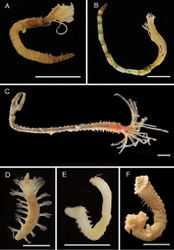Sabellidae
| Notice: | This page is derived from the original publication listed below, whose author(s) should always be credited. Further contributors may edit and improve the content of this page and, consequently, need to be credited as well (see page history). Any assessment of factual correctness requires a careful review of the original article as well as of subsequent contributions.
If you are uncertain whether your planned contribution is correct or not, we suggest that you use the associated discussion page instead of editing the page directly. This page should be cited as follows (rationale):
Citation formats to copy and paste
BibTeX: @article{Gunton2021ZooKeys1020, RIS/ Endnote: TY - JOUR Wikipedia/ Citizendium: <ref name="Gunton2021ZooKeys1020">{{Citation See also the citation download page at the journal. |
Ordo: Phyllodocida
Familia: Sabellidae
Name
gen. sp. 1 – Wikispecies link – Pensoft Profile
Diagnosis
Small-bodied species. Several very small specimens (1.5 mm long including crown). Eight thoracic and 8–14 abdominal chaetigers, branchial crown with three pairs of radioles. Radioles with flanges, long pinnules and at least one pair of long ventral radiolar appendages present, dorsal lips present. Posterior peristomial ring collar present, with entire dorsal margin (no mid-dorsal gap), ventrally slightly higher with short mid-ventral incision. Glandular ridge present on chaetiger 2, inconspicuous. Thoracic notochaetae include superior elongate narrowly-hooded chaetae and an inferior row of bayonet chaetae only (paleate chaetae absent). Thoracic uncini acicular with long curving shaft and slight subdistal swelling, with rows of different-sized teeth above main fang, companion chaetae absent. Abdominal neurochaetae narrowly-hooded; abdominal uncini avicular with rasp-shaped teeth above main fang, short neck, quadrangular breast, handle absent. Pygidium without eyespots due to preservation. Pygidial cirrus absent. Anal flanges and depressions absent.
Remarks
Due to small size of specimens, examination of uncinal teeth was difficult, and a positive identification to genus was not able to be confirmed. Specimens were stained with methyl blue and photographed to show staining pattern. Some characters of the genus Amphicorina could be observed: eight thoracic and at least eight abdominal chaetigers; three pairs of radioles with few pinnules, long ventral pinnular appendages present; glandular girdle on chaetiger 2; thoracic notochaetae either elongate and narrowly-hooded or small thin bayonet chaetae (with paleate chaetae absent entirely), thoracic uncini acicular with rows of teeth over main fang (though presence of one larger proximal tooth was not observable); abdominal neurochaetae narrowly-hooded, uncini rasp-shaped; posterior anal depression absent. The collar features are, however, more consistent with Chone or Jasmineira, though the chaetal features are more consistent with Amphicorina. However, Amphicorina is more typically recorded from shallow and nearshore waters than deep and has not been reported previously from abyssal depths.
Records
6 specimens. Suppl. material 1: ops. 42, 68 (AM).
Taxon Treatment
- Gunton, L; Kupriyanova, E; Alvestad, T; Avery, L; Blake, J; Biriukova, O; Böggemann, M; Borisova, P; Budaeva, N; Burghardt, I; Capa, M; Georgieva, M; Glasby, C; Hsueh, P; Hutchings, P; Jimi, N; Kongsrud, J; Langeneck, J; Meißner, K; Murray, A; Nikolic, M; Paxton, H; Ramos, D; Schulze, A; Sobczyk, R; Watson, C; Wiklund, H; Wilson, R; Zhadan, A; Zhang, J; 2021: Annelids of the eastern Australian abyss collected by the 2017 RV ‘Investigator’ voyage ZooKeys, 1020: 1-198. doi
Images
|
